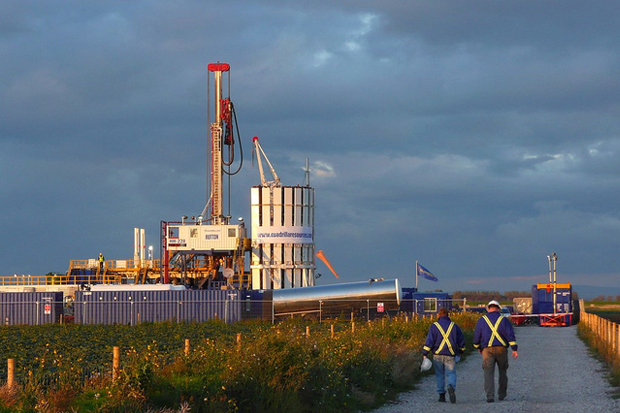The debate about hydraulic fracturing for shale gas exploitation (fracking) has been raging constantly in the UK since 2007 when the prospect of drilling for shale gas was first proposed. Since then, the British government, having looked at the US experience and decided that it wants a piece of the action, has embraced the idea.
Swiss chemicals giant INEOS has recently announced their intention to invest £640 million in shale gas exploration in the UK, a figure that is considerably larger than any of the budgets proposed by the other companies interested in this sector. The company is planning to substantially increase its shale gas interests in a bid to become one of the biggest players in the UK shale gas sector.
Fracking is potentially even more controversial in the UK than it has been in the US. Environmental groups such as Greenpeace and Friends of the Earth are directly opposed to the process and have rapidly moved to denounce INEOS plans. The prime reasons for environmentalist opposition to shale gas include, as they do in America, environmental damage, effect on climate change, water depletion, seismic effects, the pollution of groundwater by methane and fracking fluids and the impact on neighbouring communities, given the density of the population in the UK. This is essentially why, at present, official estimates of UK gas reserves do not include shale gas.
Then there are the issues concerning distraction from the longer term task of replacing fossil fuels with renewables. Despite its view that shale gas will play an important role in the UK energy mix, the Chartered Institute of Water and Environmental Management (CIWM) argues that shale gas should not undermine the drive for energy efficiency or renewable energy because sustained investment is required in those sectors in order to decarbonise the electricity sector. It additionally warns that shale gas extraction will act to exacerbate the UK’s difficulties with regard to meeting its climate change targets.
Those environmental concerns aside, the really big question for the average citizen in the UK, concerned about energy bills, is whether shale gas really will help to lower energy prices. The available evidence suggests not.
Despite the British government’s enthusiasm for fracking, which is based on the positive US experience in which shale gas extraction has helped to turn around the country’s economic fortunes, Deutsche Bank pointed out in 2011 that the US has been in a far better position to recover shale gas than the UK, due to advantages in equipment, drilling services, infrastructure, mineral rights legislation and population density. This means that in Europe and the UK, the process of extraction, assuming there are significant resources to be had, will be drawn out over a much longer term and will impose far greater costs than those the US has had to meet.
The really fundamental problem with shale gas in the UK is that no-one is really sure just how much of it exists. Cuadrilla believes, on the basis of its two test drills conducted so far, that the Bowland Shale covered by its licence is around 1,000 metres thick, as opposed to just 90 metres thick in most of the areas covered by US operations. Based on the data from its activities up to September 2011, the company estimated a figure of 5,660 billion cubic metres (bcm), of which 20 percent would be recoverable, thus a final recoverable amount of 1,132bcm. Island Gas meanwhile estimated 131bcm incorporating a risk factor of 50 percent while Composite Energy estimates 34bcm in their PEDL 1333 area. GreenPark Energy focuses mainly on coal, although it has been test drilling in Canonbie, Dumfries and Galloway since 2009.
This means that out of the four companies operations, only Cuadrilla has presented measured data. Under their commercialisation scenarios, recoverable shale gas from their licences peaks in 2026 and then declines, providing an amount equivalent to about ten months of UK consumption. A report produced by the Tyndall Centre estimates that over a 20 year period, between 2,600 and 3,000 wells would need to be developed in order to achieve a sustained annual output of 9bcm per year. This would require an average of 130 to 150 wells developed per year.
The BGS/DECC Shale Gas report of 2010 warned that US analogies used to generate current estimates may be invalid and that the gas content of UK shale remains unknown. The BGS (British Geological Survey) does concede that there is a substantial amount of shale at depth, but the shale gas potential it represents is unclear.
In this same report, updated in 2012, DECC (The Department of Energy and Climate Change) further concludes that “it is far from certain that the conditions that underpin shale gas production in North America will be replicable in the UK.” Meanwhile the Tyndall Centre for Climate Change Research points out that hopes of shale gas acting as a ‘bridging fuel’ while renewable energy infrastructure is developed in the UK cannot be realistically assumed. Even more damning is the conclusion by the government’s own Climate Change Committee (CCC) that shale gas produced either in the UK or in Europe is unlikely to reduce natural gas prices. In this respect, the US experience is unique.
It is highly unlikely therefore that shale gas will have any impact on rising energy bills in the UK. Given that it can hardly be considered a low carbon fuel, one then has to ask why on earth fracking was considered as a viable energy measure in the country in the first place.
Analysis by Robin Whitlock
